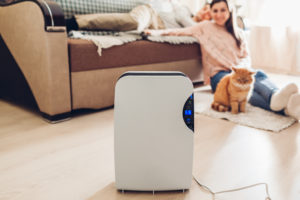DEHUMIDIFIERS 101
What do you know about dehumidifiers? One of the most widely used appliances in American homes, dehumidifiers have made significant technological advancements over the past few years. Today’s dehumidifiers are relatively inexpensive, compact, and so quiet that you may not even notice you have one running in the background. But how do they work? And would you benefit from having one in your home?
- Dehumidifiers, as the name implies, pull humidity from the air, creating a drier environment. How is this accomplished? A room dehumidifier works much like an air conditioner. It pulls in air, which passes over cooled coils. As the air cools, its moisture condenses and falls into a drip pan. The air is then reheated and released into the room slightly warmer and much dryer than it was initially. When the selected level of humidity is reached, the dehumidifier will automatically turn off.
- There are many benefits to using a dehumidifier. Reduced humidity makes your home less hospitable to dust mites, mold, mildew, and other allergens. What’s more, removing excess water from the air can reduce musty smells that often accompany dampness, mold, and mildew. In a less humid environment, food stays fresh longer, clothes dry more quickly, electronics and tools are less likely to rust or corrode, clothes, books, and furniture are less likely to encounter mold and mildew, and the air conditioner works more efficiently, which means lower energy costs.
- Do you need a dehumidifier? The first sign that you need a dehumidifier may be that you’re experiencing allergy symptoms. Most allergy triggers thrive in damp environments, so if you’ve got too much moisture in your home, you may find yourself sneezing, wheezing, and suffering from a stuffy nose, itchy, watery eyes, or skin rashes and other signs of irritation. On the other hand, your home may be showing signs of too much humidity. These include water stains on the walls or ceilings, condensation on the windows, musty smells, or black spots growing in high humidity areas, like the bathroom.
- How do you choose the right dehumidifier? There is a wide range of options, and which dehumidifier you choose depends largely on where you need to use it. The size of the room factors in, as does the amount of humidity you need to remove, and any special features you might need. It’s a good idea to shop around, learning as much as you can about dehumidifiers before you decide on the unit you’ll purchase.
A dehumidifier can help prevent mold, but if you already have a mold problem that needs attention, call Indoor Green Solutions. We’ve got more than 10 years of experience remediating mold, not just removing mold from houses, but providing preventative measures to keep the mold from coming back. Nationwide Certified Mold Assessors and Remediators, we use EPA certified methods, and guarantee 100 percent satisfaction, providing a warranty for all of our services. Contact us through our website or call 888-707-5285 for your free estimate.

